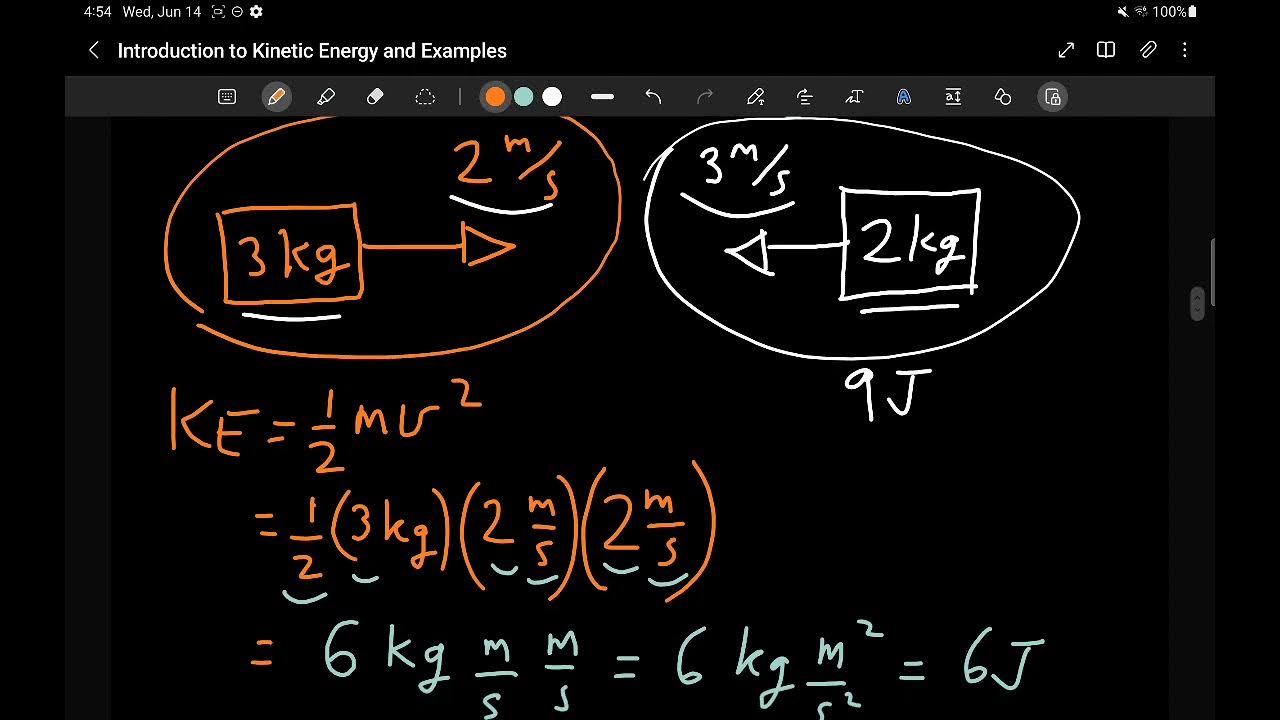GCSE Physics - Kinetic Energy #2
Summary
TLDRThis video explains what kinetic energy is and how to calculate it using the formula KE = 1/2 mv². Kinetic energy depends on an object's mass and speed, with faster and heavier objects having more kinetic energy. The video compares the kinetic energy of a plane and a particle, highlighting how mass and speed influence energy. By applying the equation and converting units, it shows that despite the particle moving faster, the plane has more kinetic energy due to its larger mass. The video provides a clear, step-by-step explanation of the concept.
Takeaways
- ⚡ Kinetic energy is the energy an object possesses due to its motion.
- 🏃♂️ The faster an object moves, the more kinetic energy it has.
- ⚖️ The mass of an object also affects its kinetic energy: more mass means more kinetic energy, assuming the speed is the same.
- 🛩️ A plane with a large mass will have more kinetic energy than a small particle, even if both are moving at the same speed.
- 📉 If a large object moves slowly, it might still have more kinetic energy than a small object moving very fast.
- 📐 The formula for calculating kinetic energy is Ek = 1/2 mv², where 'm' is mass and 'v' is velocity (or speed).
- 🔄 Units must be consistent: mass should be in kilograms and speed in meters per second when using the formula.
- 💡 The energy result from the equation is measured in joules, the standard unit for energy.
- 🔢 A fast-moving particle with low mass may still have less kinetic energy than a slower, much heavier object.
- 🎯 Even though speed is a key factor in kinetic energy, mass plays an equally crucial role in determining the final energy value.
Q & A
What is kinetic energy?
-Kinetic energy is the energy an object possesses due to its motion. Any moving object, such as a plane or a particle, has kinetic energy.
What two factors affect the amount of kinetic energy an object has?
-The two factors that affect kinetic energy are the object's speed and its mass. Faster objects have more kinetic energy, and objects with more mass have more kinetic energy if speed is kept constant.
How does speed influence kinetic energy?
-The faster an object is moving, the more kinetic energy it has. This is because a lot of energy must be transferred to an object to speed it up, and that energy is stored in its kinetic energy.
How does mass influence kinetic energy?
-For objects moving at the same speed, the more massive object will have more kinetic energy. This means that even if two objects are moving at the same velocity, the object with the greater mass will store more kinetic energy.
What equation is used to calculate kinetic energy?
-The equation to calculate kinetic energy is Ek = 1/2 mv², where Ek is the kinetic energy, m is the mass in kilograms, and v is the velocity (or speed) in meters per second.
What are the units used in the kinetic energy equation?
-In the kinetic energy equation, energy (Ek) is measured in joules (J), mass (m) is measured in kilograms (kg), and velocity (v) is measured in meters per second (m/s).
How do you convert tons to kilograms?
-To convert tons to kilograms, you multiply the number of tons by 1,000. For example, 20 tons is equal to 20,000 kilograms.
How do you convert grams to kilograms?
-To convert grams to kilograms, you divide the number of grams by 1,000. For example, 0.1 grams is equal to 0.0001 kilograms.
How is the kinetic energy of a plane and a particle compared in the example?
-In the example, the plane has more kinetic energy than the particle despite moving slower because the plane's mass is much greater. The plane's kinetic energy is 250,000 joules (or 250 kilojoules), while the particle's is 800 joules (or 0.8 kilojoules).
Why does the particle, moving much faster than the plane, still have less kinetic energy?
-The particle has less kinetic energy than the plane because its mass is much lower. Even though the particle is moving much faster, its small mass results in less kinetic energy overall.
Outlines

このセクションは有料ユーザー限定です。 アクセスするには、アップグレードをお願いします。
今すぐアップグレードMindmap

このセクションは有料ユーザー限定です。 アクセスするには、アップグレードをお願いします。
今すぐアップグレードKeywords

このセクションは有料ユーザー限定です。 アクセスするには、アップグレードをお願いします。
今すぐアップグレードHighlights

このセクションは有料ユーザー限定です。 アクセスするには、アップグレードをお願いします。
今すぐアップグレードTranscripts

このセクションは有料ユーザー限定です。 アクセスするには、アップグレードをお願いします。
今すぐアップグレード関連動画をさらに表示

Introduction to Kinetic Energy with Example Problem

Work and Energy | Grade 8 Science DepEd MELC Quarter 1 Module 3 Part 3 Kinetic Energy

Kinetic energy derivation | Work & Energy | Physics | Khan Academy

FISIKA KELAS XI | TEORI KINETIK GAS (PART 3) - Tekanan dan Energi Gas Ideal

Teorema Trabalho-Energia | Física 1

Introduction to Kinetic Energy and Examples
5.0 / 5 (0 votes)
